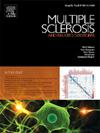High intensity dynamic stability gait training for people with multiple sclerosis: a pilot study
IF 2.9
3区 医学
Q2 CLINICAL NEUROLOGY
引用次数: 0
Abstract
Background and Purpose
This report describes the initial results of an ongoing single blinded, randomized clinical trial aimed to improve mobility and balance for people with multiple sclerosis (PwMS) through high intensity dynamic stability gait training. PwMS demonstrate consistent, but relatively small improvements in mobility and balance following exercise interventions,1-2 which often fall below the minimally clinically important differences (MCID) reported for other clinical populations.3 Based on recommendations for other neurologic populations, more task specific interventions at higher intensities may facilitate greater improvements in mobility and balance.4
Methods
PwMS were enrolled in a 10-week trial consisting of three 1-hour visits per week with up to 40 minutes of walking each. Participants walked at either low (LIT) or high (HIT) cardiovascular intensities, in a static or dynamic environment. LIT targeted intensities of 30-50% heart rate reserve (HRR), while HIT targeted 70-80% HRR. Dynamic environments involved discrete reactive balance perturbations every 20 seconds, while static environments did not. Blinded clinical assessments were completed before, midway, and after training. Outcome measure changes were assessed between the first and last completed assessment.
Results
More HIT participants demonstrated changes above the MCID for walking speed assessments (Self Selected Walking Speed, 7/12 HIT, 3/13 LIT; Fast Walking Speed, 8/12 HIT, 5/13 LIT; 25ft Walk Test, 2/12 HIT, 2/13 LIT) and the 6 Minute Walk Test (5/12 HIT, 3/13 LIT) than their LIT counterparts. Similar numbers of participants in the static and dynamic groups met MCIDs for balance measures (Functional Gait Assessment, 4/13 dynamic, 5/14 static; Berg Balance Scale, 0/13 dynamic, 1/14 static; Activities of Balance Confidence Scale, 2/13 dynamic, 2/14 static).
Discussion
PwMS undergoing HIT are more consistently meeting MCIDs for gait speed and endurance than their LIT counterparts, however changes in balance are similar between static and dynamic groups. Changes in reactive balance may be task specific and not captured by the current balance measures.
针对多发性硬化症患者的高强度动态稳定步态训练:一项试点研究
背景与目的本报告介绍了一项正在进行的单盲随机临床试验的初步结果,该试验旨在通过高强度动态稳定步态训练改善多发性硬化症患者(PwMS)的活动能力和平衡能力。多发性硬化症患者在接受运动干预后,其活动能力和平衡能力得到了持续但相对较小的改善,1-2 通常低于其他临床人群所报告的最小临床重要性差异(MCID)。3 根据针对其他神经系统人群的建议,更高强度、更具任务针对性的干预措施可能有助于进一步改善活动能力和平衡能力。参与者在静态或动态环境中以低强度(LIT)或高强度(HIT)的心血管运动强度步行。低强度步行的目标强度为 30-50% 的心率储备 (HRR),而高强度步行的目标强度为 70-80% 的心率储备 (HRR)。动态环境涉及每 20 秒一次的离散反应平衡扰动,而静态环境则不涉及。在训练前、训练中和训练后均完成了盲法临床评估。结果 在步行速度评估(自选步行速度,7/12 名 HIT,3/13 名 LIT;快速步行速度,8/12 名 HIT,5/13 名 LIT;25 英尺步行测试,2/12 名 HIT,2/13 名 LIT)和 6 分钟步行测试(5/12 名 HIT,3/13 名 LIT)方面,HIT 参与者的变化超过 MCID 的人数多于 LIT 参与者。静态组和动态组中达到平衡测量 MCID 的人数相近(功能步态评估,动态组 4/13,静态组 5/14;Berg 平衡量表,动态组 0/13,静态组 1/14;平衡活动信心量表,动态组 2/13,静态组 2/14)。反应性平衡的变化可能与特定任务有关,目前的平衡测量方法无法捕捉到这种变化。
本文章由计算机程序翻译,如有差异,请以英文原文为准。
求助全文
约1分钟内获得全文
求助全文
来源期刊

Multiple sclerosis and related disorders
CLINICAL NEUROLOGY-
CiteScore
5.80
自引率
20.00%
发文量
814
审稿时长
66 days
期刊介绍:
Multiple Sclerosis is an area of ever expanding research and escalating publications. Multiple Sclerosis and Related Disorders is a wide ranging international journal supported by key researchers from all neuroscience domains that focus on MS and associated disease of the central nervous system. The primary aim of this new journal is the rapid publication of high quality original research in the field. Important secondary aims will be timely updates and editorials on important scientific and clinical care advances, controversies in the field, and invited opinion articles from current thought leaders on topical issues. One section of the journal will focus on teaching, written to enhance the practice of community and academic neurologists involved in the care of MS patients. Summaries of key articles written for a lay audience will be provided as an on-line resource.
A team of four chief editors is supported by leading section editors who will commission and appraise original and review articles concerning: clinical neurology, neuroimaging, neuropathology, neuroepidemiology, therapeutics, genetics / transcriptomics, experimental models, neuroimmunology, biomarkers, neuropsychology, neurorehabilitation, measurement scales, teaching, neuroethics and lay communication.
 求助内容:
求助内容: 应助结果提醒方式:
应助结果提醒方式:


